INTEL MACS, WINDOWS VISTA
Adobe Announces Public Beta of Photoshop CS3
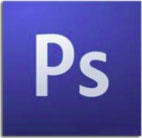 By MIKE PASINI
By MIKE PASINIEditor
The Imaging Resource Digital Photography Newsletter
Encouraged by its experience with the Lightroom public beta, Adobe has announced it will offer a public beta of Photoshop CS3, the next version of the company's professional image editing software. The beta package, the first version of Photoshop to run natively on Intel-based Macs, includes Adobe Bridge, too.
With the final version expected to ship in Spring 2007, the beta for both Macintosh and Windows users will be available at Adobe Labs (http://labs.adobe.com/technologies/photoshopcs3/) tomorrow as a 750-MB download in English only.
While anyone can download the beta, you need a Photoshop CS2, Creative Suite, Production Studio or Bundle serial number to get a Photoshop CS3 beta serial number. The beta serial number is required to activate the Photoshop beta and use it beyond the two-day grace period.
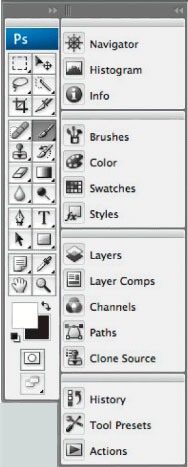
New Interface. Tool bar (left) and Iconified palettes (right).
NEW FEATURES | Back to Contents
While Adobe said the primary reason for the beta was "to allow our Macintosh customers to run Photoshop natively on the latest Intel based systems," the company is interested in what Windows users have to say about their new features, too.
Among the productivity highlights of the CS3 public beta are:
- A streamlined interface
- Next-generation Camera Raw
- Adobe Bridge with Stacks and Filters
- Zoomify Export
- Lightroom integration
- Improved, Intuitive Printing
Editing highlights include:
- Non-destructive Smart Filters
- Vanishing Point with multiple, easily adjustable angle perspective planes
- Enhanced Black and White conversion
- Improved Curves
- Adjustable Cloning and Healing with preview overlay
- Enhanced Merge to 23-Bit HDR
Compositing highlights include:
- Quick Selection tool
- Refine Edge
- Automatic layer alignment and blending
- Photomerge with advanced alignment and blending
While admitting "there are indeed some cool things we're not yet discussing," Nack confirmed that some Raw Shooter technology will also make it into the CS3 upgrade if not the beta, including the Vibrance control and "some cool quality enhancements around skin tones, etc."
DEVICE CENTRAL | Back to Contents
Also included in the beta is Adobe's new Device Central technology geared toward creative professionals designing mobile content. It makes it possible to view mobile content like phone wallpapers or application mockups in Photoshop using Adobe Device Central software's built-in device profiles and testing environment.
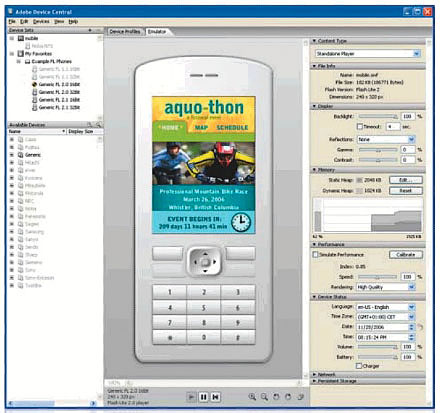
Device Central. Create your artwork in Photoshop and 'print it' using a device profile to see how the device renders it.
From within Adobe Device Central you can tune your designs for various mobile screen sizes and lighting conditions. Just apply a different device profile to your artwork to see how it is rendered by that device.
John Nack, Photoshop senior product manager, demonstrated a few of the new features for the press recently.
Even a cursory glance revealed both Photoshop and Bridge have borrowed liberally from Lightroom's interface. Bridge was a bit more attractive and better organized with some changes to its internal operation to emphasize speed, Nack said. It also includes a loupe tool with metadata and keyword assignment.
Another nice touch was that palettes in Photoshop can be "iconified," as Nack put it, reducing them to small buttons that expand into full-sized palettes when clicked. You can stack more buttons than you can put tabs in a well. Palettes can also disappear and reappear like the Macintosh dock, so they are available when you need them and out of the way when you don't.
Quick Selection addresses manual mask creation, one of the more aggravating aspects of image editing. Nack said users have told Adobe they don't want <i>more</i> features so much as <i>better</i> ones. And Quick Selection is an example. You simply paint your mask in with a brush that gobbles up areas of the image much like the Magic Wand constrained by the Magnetic Lasso, except you have some control with the brush (rather than a numerical threshold or ill-defined edge) over what it includes and doesn't. It seems to adjust its threshold automatically as you add and subtract making it fairly easy to get a rough mask in just a few seconds. This looked a little smarter than the similar Photoshop Elements 4.0 technology.
With Smart Filters, you can now apply filters and remove them much like Adjustment Layers. Based on Adobe's Smart Object technology, Smart Filters provide another non-destructive editing tool.
The Automatic Layer Alignment feature can merge two similar images in perfect alignment, then let you blend them by painting in the features from each you want to see in the final. Nack demonstrated this feature by aligning two shots of a lineup of Adobe undesireables and painting over the faces of those who were distracted in one shot, replacing their mugs with more flattering shots from the other shot. The blend was so natural it reminded us of Adobe's Photomerge panorama stitching prowess. Seamless.
Vanishing Point enhancements let you build and lay grids at any angle just by dragging a control point.
PERFORMANCE | Back to Contents
Nack shared early benchmarks for launch time and over 250 common operations.
Launch time averaged across multiple platforms and configurations was 20 percent faster, with the greatest improvement on Intel-based Macs (over twice as fast) and Windows Vista (also over twice as fast). PowerPC and Windows XP launch time was significantly if not quite as dramatically improved.
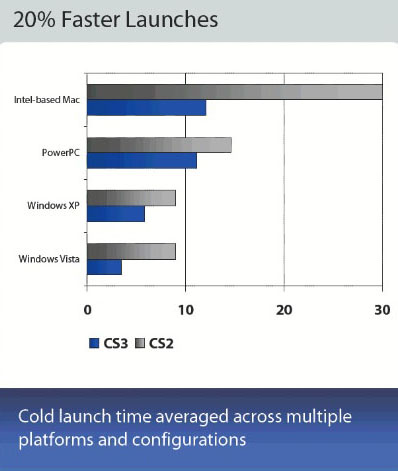
Faster Launch. Intel Macs and Vista show the most gains, but Photoshop launches faster on every platform.
The 250 operation test report highlighted Open As (about twice as fast), Save As (nearly twice as fast), Smart Sharpen (over four times as fast), Gaussian Blur (about twice as fast), Brightness/Contrast (well over twice as fast), Curves (twice as fast) and Smart Object (nearly three times as fast).
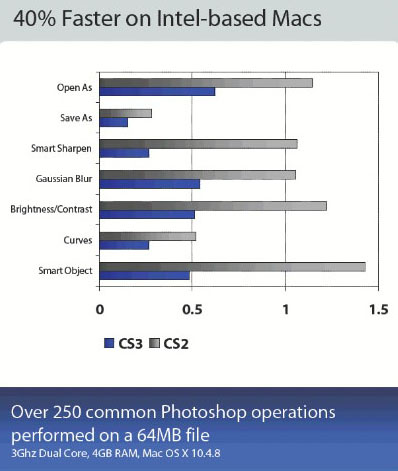
Faster Operations. Test file was 64MB.
PLUG-IN SUPPORT | Back to Contents
While Windows users can expect to use their favorite filters in the new version, Mac users may wonder how welcome their old favorites are in the new version.
Nack told us that CS3 will indeed support older CFM-style plug-ins just as CS2 did, as well as the Mach-O architecture plug-ins introduced in CS2. How well -- or even if -- these will run under Rosetta on an Intel processor on the Mac is another issue.
SYSTEM REQUIREMENTS | Back to Contents
Adobe has upped the hardware ante slightly for CS3, eliminating support on the Mac for the G3 processor and on Windows the Pentium III. RAM, disk space, video card support and miscellaneous requirements remain the same. The company reported the following system requirements for each platform.
On the Macintosh:
- PowerPC G4 or G5 or Intel based Macintosh processor
- Mac OS X vs.10.4.8
- 320-MB of RAM (512-MB recommended)
- 512 minimum of RAM if you are running Adobe Bridge as well
- 64-MB of video RAM
- 1.5-GB of available hard-disk space
- 1024x768 monitor resolution with 16-bit video card
- DVD-ROM drive
- Internet or phone connection required for product activation
- QuickTime 7 software required for multimedia features
For Windows:
- Intel Pentium 4, Intel Centrino, Intel Xeon or Dual-Core Intel Xeon processor
- Microsoft Windows XP with Service Pack 2 or Windows Vista
- 320-MB of RAM (512-MB recommended)
- 512 minimum of RAM if you are running Adobe Bridge as well
- 64-MB of video RAM
- 650-MB of available hard-disk space
- 1024x768 monitor resolution with 16-bit video card
- DVD-ROM drive
- Internet or phone connection required for product activation
- QuickTime 7 software required for multimedia features
The company is not providing support for the beta, but in addition to the user forums will maintain Web pages for both Photoshop and Bridge:
- Downloads: http://labs.adobe.com/technologies/photoshopcs3/
- Forums: http://labs.adobe.com/technologies/photoshopcs3/
- New features list: http://labs.adobe.com/ technologies/photoshopcs3/
- Release Notes: http://labs.adobe.com/technologies/photoshopcs3/
- John Nack's Photoshop blog: http://blogs.adobe.com/jnack/
- Bridge blog: http://blogs.adobe.com/bridge/
- Mobile Device Authoring at Bill Perry's blog (Perry is manager of Adobe�s developer relations for mobile and devices): http://www.flashdevices.net/mobileauthoring/